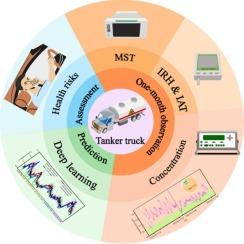油罐车舱室甲醛排放:观察、深度学习预测和健康风险评估
IF 8
1区 环境科学与生态学
Q1 ENVIRONMENTAL SCIENCES
引用次数: 0
摘要
油罐车是石油运输不可或缺的工具,驾驶员在驾驶室微环境中的舒适和健康与道路安全密切相关。然而,油罐车车内空气质量的长期监测和预测方法仍有待探索。本研究首次对某新型油罐车舱内甲醛释放动态进行了量化,并确定了影响舱内甲醛释放的关键因素。在一个多月的现场活动中,获得并分析了机舱内的时间分辨甲醛浓度,根据世卫组织指南的阈值(0.1 mg/m3),超出率为83.5%。晴天甲醛浓度较高且分布较广,阴天和雨天甲醛浓度较低。通过特征重要性分析,确定材料表面温度是影响甲醛排放的主要因素。然后,我们开发了一个深度学习模型来预测甲醛的长期动态,与传统模型相比,该模型具有出色的预测精度。不同车辆舱室的暴露评估强调了卡车舱室的重大健康风险。该研究提供了油罐车甲醛动力学的第一个真实世界数据和模型,表明了对来源进行表征和控制以保持驾驶员健康的必要性。本文章由计算机程序翻译,如有差异,请以英文原文为准。

Formaldehyde emissions in tanker truck cabins: Observation, deep learning prediction and health risk assessment
Tanker trucks are indispensable for petroleum distribution, with driver comfort and health in the cabin microenvironment closely tied to road safety. However, long-term monitoring and prediction methods for in-cabin air quality in tanker trucks remain underexplored. This study makes the first attempt to quantify formaldehyde emission dynamics and identify key influencing factors in a new tanker truck cabin. Over one month of field campaign, the time-resolved formaldehyde concentrations in the cabin were obtained and analyzed, revealing an exceeding rate of 83.5 % according to the threshold (0.1 mg/m3) of WHO guidelines. Higher and more widely distributed formaldehyde concentrations were observed on sunny days, with lower levels on cloudy and rainy days. Material surface temperature was identified as the primary factor driving formaldehyde emissions via feature importance analysis. We then developed a deep learning model to predict long-term formaldehyde dynamics, which demonstrated excellent prediction accuracy by compared with traditional models. Exposure assessment among varied vehicle cabins highlighted significant health risks in truck cabins. This study provides the first real-world data and modelling on formaldehyde dynamics in tanker trucks, indicating the necessity of source characterization and control to keep drivers healthy.
求助全文
通过发布文献求助,成功后即可免费获取论文全文。
去求助
来源期刊

Science of the Total Environment
环境科学-环境科学
CiteScore
17.60
自引率
10.20%
发文量
8726
审稿时长
2.4 months
期刊介绍:
The Science of the Total Environment is an international journal dedicated to scientific research on the environment and its interaction with humanity. It covers a wide range of disciplines and seeks to publish innovative, hypothesis-driven, and impactful research that explores the entire environment, including the atmosphere, lithosphere, hydrosphere, biosphere, and anthroposphere.
The journal's updated Aims & Scope emphasizes the importance of interdisciplinary environmental research with broad impact. Priority is given to studies that advance fundamental understanding and explore the interconnectedness of multiple environmental spheres. Field studies are preferred, while laboratory experiments must demonstrate significant methodological advancements or mechanistic insights with direct relevance to the environment.
 求助内容:
求助内容: 应助结果提醒方式:
应助结果提醒方式:


